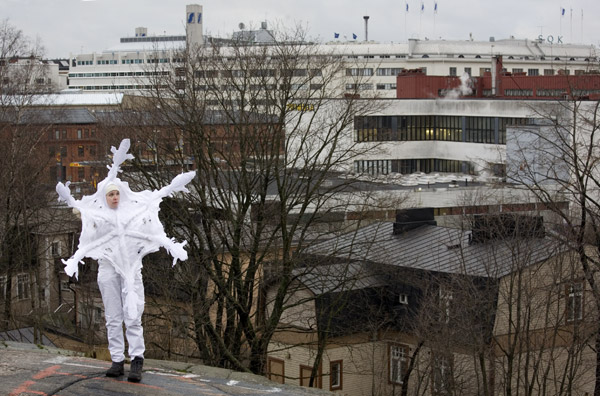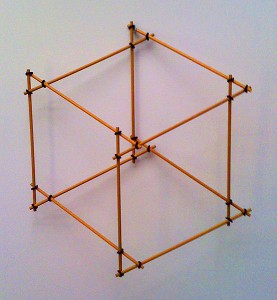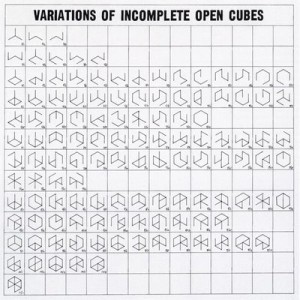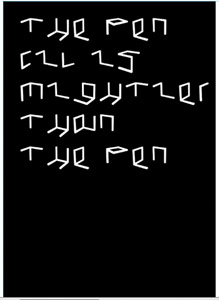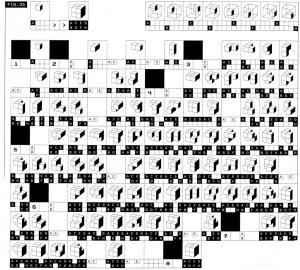The room is dark. In the speakers is heavy breathing. In the far en of the room is a black tent, it is moving from within as if something is trying to get out. On the floor is twenty white parallel lines leading away from the tent and branching out into a labyrinth. As the breathing stops a heavy beat start to pulsate. Out of the tent comes, one after the other, strange figures in costumes, they look as if they were characters walking out of a Bosch painting. This is the beginning of a performance that was the result of a Design class in word and image. The performance makes me think of the finnish artist Riita Ikonen who uses costumes in her performances but in a more playful way.
Archive for January, 2009
inarticulate happening
Saturday, January 10, 2009
It al started with a confusing assignment, or was there even an assignment?
An inarticulate happening, which nobody can define, but it does have all the aspects of image and language. Control-able vagueness including ideas about social subgroups. Collaboration with a confusing problem that was created out of nothing. Or was the problem there already? Is it complete chaos or efficient harmony. If this “class” has a name, we don’t know what it is. But we don’t know if it needs a name. And where are the boundaries? Are there boundaries? Do we need them? link to: perspicuity.net/paradox/vagueness
posted by Vincent Knopper
Tribe 2
Saturday, January 10, 2009
I want to introduce Nadja Voorham. She likes to dance and she wants to be a part of a tribe with no rules and religion. The biggest rule of them is “ music” and they call themself “Bling Bling”. It is a very strange tribe, because when music is playing around, they begin to dance. Very strange. They have to hear one tune and the dance automatically comes out. And when the music stops, the dance also stops. The tribe doesn’t care about the comment of the society. They are very loyal to their rule and their reputation. link to bling bling
posted by Raz Barsatie
Mashed
Friday, January 9, 2009
After having spend the whole day yesterday with the Jackson 5 ABC song in my head, I clearly was inspired by the subject and couldn’t let it rest!
While still searching for an alphabet, Karoenja sat down eating his peanut butter sandwich with a surprising huge fascination of the relief of the butter! He started looking at all other kinds of structures in vegetables. He dove into the Dutch foods; which reminded him of mashed food (hollandse trots!). First have the vegetable in their natural “earthy” state, then you peel of the skin, cook them, mash them, pour gravy over it, finally eat it!
During this process he documented every step by photographing his actions, witch resulted in his personal alphabet
posted by Tessel Schole
Dress To Leave An Impression
Friday, January 9, 2009
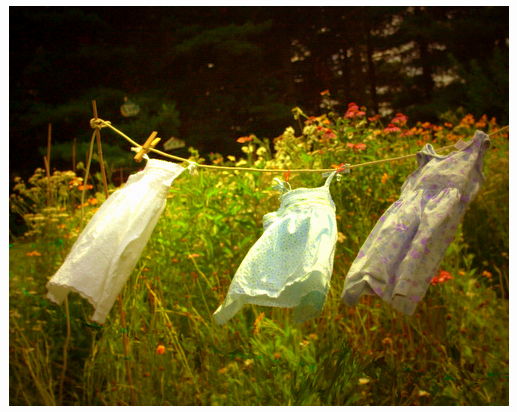
In the first four weeks of the basic year, „e“ and her class were instructed by the teachers to: „Make us remember you.“ They used nicknames, objects, made works and performances. This was the first design project, so the whole working process was new to the students. But the teachers were there to talk, direct, and give hints to inspirational sources. „e“ decided that she could best communicate her personality by talking about her favourite dresses and the memories, emotions and characteristics connected to them. The students got to know each other very well through that project by seeing each person‘s creative expression of themselves.
Link: to the pdf file: http://www.amsreview.org/articles/kleine01-2004.pdf
posted by Jane Mumford
Language + Image: as an introduction of design itself…
Friday, January 9, 2009
A big theme “Photography” as a starting point, but worked out in a straight form….
Find a collection of photo prints in a way you think they fit together (no glamour or arty once)… present the series and, of course, discuss a lot with the group…
What can you see… What is going on there…
What is happening with the relation between the pictures…
Next step… think further and create a “Photo story” with some more found pieces…
Of course discussion…
The last one should be a reaction, in anyway, on one photo out of the story…
Yeah… Discussion… yeah…
posted by Lena Hendlmeier
The Tribe
Thursday, January 8, 2009
Let me tell you something about Jesse Muller.
Jesse has a social handicap. She is a perfectionist.
She wears a suit – I call it the ‘what-I’m-not-supposed-to-look-like-but-want-to-look-like-suit’. – Jesse is part of a tribe that can not function in society because of their social handicaps. This is why they only come out at night.
If you ever come across any members of the tribe – who I can tell you are pretty shocking, have you ever seen a man with six arms? – be sure to move out of the way.
Somewhere there is a book about this mysterious tribe. But I am affraid that – just like the tribe – it only comes out at night
posted by Charlie Bakker
The cube as a representation of a democratic art form
Wednesday, January 7, 2009
With a speech by Simon den Hartog, former director of The Gerrit Rietveld Academie, a small retrospect exhibit on the work of Jan Slothouber was openened at the “van Abbemuseum” in Eindhoven NL. An intimate group of affectionado’s and family bridged the gap of almost 50 years, when Jan Slothouber together with Willem Graatsma started his fascinating journey into the world of the cube. The Centre of Cubic Constructions represented a highlight in this extraordinary focussed research, culminating in the 1970 representation at the Venice Biennale.
Seemlessly scanning the architectoral space occupied by art and design, the exhibit –designed by Erik Slothouber and curated by Diana Franssen– clearly presented an extraordinary focussed spectrum of work
Some weeks later we revisitted this exhibit with a student research team of the FoundationYears C group. Exploring the cubic constructions we found direct relations between the work of Slothouber and the minimal art of Sol LeWitt. The choice for a simple universal and modular form makes it posible to built a grammar for an entire body of work in which all the steps in the process can become interesting in their own right. “in which even the concept can become as interesting as the final product” (Sol Lewitt, cat Sonsbeek 71).
The specific context of typedesign addressed in our workshop presented striking relation between their works and those of more contemporary designers like Radim Pesko and the Swiss designers Dimitri Bruni & Manuel Krebs of Norm
More research was conducted to explore related content or workapproach of other designers like, Bram de Does, Karl Nawrot, Na Kim (website) and Ji Lee.
This was part I of the C_group research.
All researches linked in this posting can be downloaded in A4 format and are also available as hard copy research prints at the ResearchFolders available at the academy library
